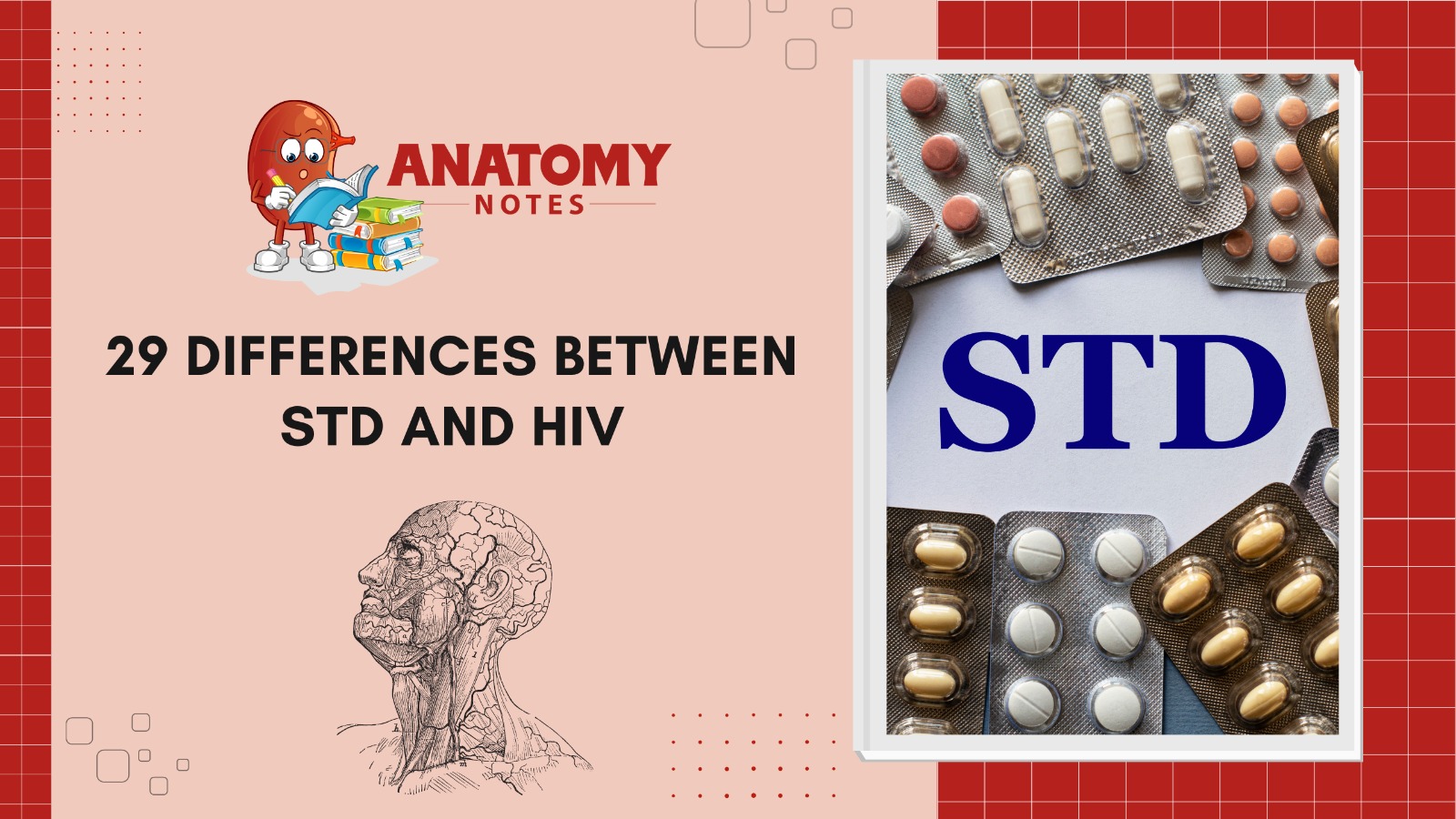Human immunodeficiency virus (HIV) and sexually transmitted diseases (STDs) are health issues pertaining to sexual health and the spread of infections.
STD (Sexually transmitted diseases)
Sexually transmitted diseases (STDs), often known as STIs, are infections that are mainly communicated through sexual activity, such as vaginal, anal, and oral sex. Other non-sexual methods of transmission include sharing needles, passing a mother’s antibodies to her unborn child, and breastfeeding. Burning, itching, or discharge in your genital area are the most typical symptoms. Since certain STIs are asymptomatic, you might not experience any symptoms.
Typical STDs consist of:
Chlamydia: A bacterial infection that frequently has no symptoms but that, if ignored, can have major side effects including infertility and pelvic inflammatory disease (PID) in females.
Gonorrhea: Another bacterial illness, gonorrhea, has comparable side effects to chlamydia. If left untreated, it might potentially result in joint and cardiac issues.
Syphilis: Syphilis is a progressive bacterial infection that can result in sores, rashes, and internal organ damage, among other symptoms.
Herpes: Herpes, which is brought on by the herpes simplex virus (HSV), can result in incredibly uncomfortable mouth or genital sores. Throughout a person’s life, it could come back.
The human papillomavirus (HPV): HPV is a family of viruses that can cause genital warts and raise your risk of developing certain malignancies, such as throat, cervical, and anal cancer.
Trichomoniasis: An infection brought on by a parasite that can cause burning, discharge, and itching.
In order to prevent STDs, one must practice safe sex, which includes wearing condoms consistently and correctly, get immunized (as with the HPV vaccine), and undergo routine screenings and tests if one is sexually active.
HIV(Human Immunodeficiency Virus)
HIV is a virus that selectively targets CD4 cells (T cells), which aid in the body’s ability to fend off diseases. HIV can cause acquired immunodeficiency syndrome (AIDS), which if untreated causes the immune system to be significantly compromised and leaves the patient vulnerable to a wide range of infections and illnesses.
The main ways that HIV spreads are:
Unprotected sexual activity: This includes having oral, anal, and vaginal sex with a partner who is infected.
Sharing needles: Using a needle that has been used by an infected person to inject narcotics.
a mother to her child: during giving birth or when nursing.
HIV prevention measures include wearing condoms regularly and correctly, getting tested, learning the HIV status of your partner, using clean needles when injecting drugs, and for those at high risk of HIV, considering pre-exposure prophylaxis
Also Read: The Skeletal System: Parts, Functions, Diagrams & Facts
|
No. |
Aspect |
STD (Sexually Transmitted Disease) |
HIV (Human Immunodeficiency Virus) |
|
1 |
Nature |
Various infections caused by bacteria, viruses, or parasites |
A virus that attacks the immune system |
|
2 |
Transmission |
Spread through sexual contact, including vaginal, anal, and oral sex |
Primarily transmitted through blood, semen, vaginal fluids, and breast milk |
|
3 |
Infection Types |
Includes a range of different infections, such as chlamydia, gonorrhea, syphilis, etc. |
Infection with HIV leads to AIDS (Advanced HIV infection) |
|
4 |
Causes |
Caused by a variety of pathogens |
Caused specifically by the HIV virus |
|
5 |
Symptoms |
Symptoms can vary depending on the specific infection |
Early symptoms may be flu-like; later stages may involve opportunistic infections |
|
6 |
Chronicity |
Some STDs can be treated and cured |
HIV is a chronic condition, not currently curable |
|
7 |
Complications |
Can lead to serious health problems if left untreated |
HIV can progress to AIDS, weakening the immune system |
|
8 |
Transmission Prevention |
Condoms and barrier methods can reduce risk |
Condoms also reduce risk; antiretroviral therapy (ART) is used to manage HIV |
|
9 |
Population Impact |
Common, affecting a significant number of people |
Global pandemic, affecting millions worldwide |
|
10 |
Vaccine Availability |
Vaccines available for some STDs |
No vaccine currently available for HIV |
|
11 |
Testing |
Testing available for various STDs |
HIV testing is available and recommended |
|
12 |
Risk Factors |
Multiple sexual partners, unprotected sex, sharing needles |
Unprotected sex, sharing needles, mother-to-child transmission |
|
13 |
Stigma |
Carries some level of social stigma |
Historically associated with stigma |
|
14 |
Transmission Route |
Typically transmitted through sexual contact |
Can be transmitted through blood, needles, mother-to-child |
|
15 |
Initial Symptoms |
Can vary significantly based on the specific STD |
Early HIV symptoms can be flu-like |
|
16 |
Long-Term Impact |
Long-term effects depend on the specific STD |
Long-term impact is AIDS-related |
|
17 |
Testing Window Period |
Window period varies depending on the specific STD |
HIV has a window period before testing positive |
|
18 |
Preventive Measures |
Condom use, regular testing, partner communication |
Condom use, regular testing, ART for those with HIV |
|
19 |
Cure Availability |
Some STDs can be cured with treatment |
HIV cannot be completely cured, but ART can control it |
|
20 |
Pregnancy Risk |
Some STDs can affect pregnancy outcomes |
HIV-positive mothers can transmit the virus to their babies |
|
21 |
Prenatal Screening |
Prenatal screenings can detect certain STDs |
Prenatal screenings can identify maternal HIV status |
|
22 |
Effect on Fertility |
Some STDs can cause infertility |
HIV and certain treatments can affect fertility |
|
23 |
Public Health Concern |
Considerable public health concern |
Major global public health concern |
|
24 |
Medical Treatment |
Treated with antibiotics or antiviral medications |
Treated with antiretroviral therapy (ART) |
|
25 |
Mode of Transmission |
Bacteria, viruses, and parasites can cause STDs |
HIV is caused specifically by the HIV virus |
|
26 |
Symptom Variability |
Symptoms can vary significantly between different STDs |
Symptoms can vary between individuals and stages of HIV |
|
27 |
Modes of Prevention |
Safe sex practices, vaccination, partner communication |
Safe sex practices, avoiding sharing needles, PrEP for prevention |
|
28 |
Impacts on Health |
Can lead to discomfort, complications, and chronic issues |
HIV can lead to a weakened immune system and opportunistic infections |
|
29 |
Global Efforts |
Global initiatives focus on prevention, education, and treatment |
Global efforts aim to increase HIV awareness, testing, and treatment |
Also Read: 45 Difference Between Fraternal and Identical Twins
Frequently Asked Questions (FAQ)
Q.1 How is the HIV virus spread?
Unprotected sexual contact, sharing needles or syringes with an infected individual, and transmission from mother to child during childbirth or breastfeeding are the main ways that HIV is spread.
Q2. What are the most typical STD symptoms?
The symptoms of each STD are unique and can include genital itchiness, burning, odd discharge, blisters or warts, pain during urination or sexual activity, and flu-like symptoms.
Q3. Can all STDs be cured?
While many STDs are treatable, not all of them are curable. Antibiotics can be used to treat and cure STDs caused by bacteria, including chlamydia, gonorrhea, and syphilis. Herpes and HIV are viral STDs that have no known cure but are treatable with medicine.
Q4. When should I have an HIV or STD test?
If you are sexually active, especially if you have several partners or engage in unprotected sex, it is advised that you get tested. If you have signs of an STD or may have been exposed to HIV, testing is very necessary.
Q5. How reliable are testing for HIV and STDs?
The accuracy of STD and HIV tests can vary depending on the type of test and the time. It’s crucial to adhere to the suggested testing guidelines, and if you have any questions, speak with a healthcare provider.
Q6. Can someone with HIV lead a normal life?
With the right medical attention and medication, persons with HIV can live long, active lives. HIV drugs can aid in virus management and stop AIDS from developing




